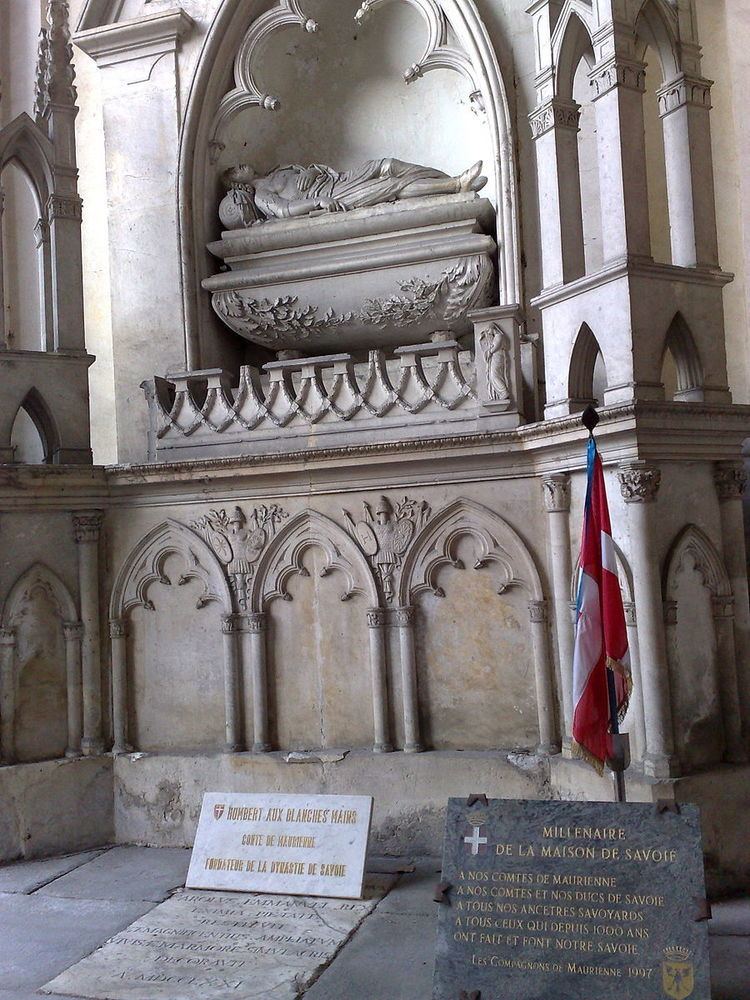Name Humbert Count | ||
 | ||
Children Otto I, Count of Savoy, Amadeus I, Count of Savoy, Burchard of Savoy Grandchildren Peter I, Count of Savoy Great grandchildren Henry V, Holy Roman Emperor Similar People Adelaide of Susa, Amadeus V - Count of Savoy, Antipope Felix V, Amadeus VI - Count of Savoy, Emmanuel Philibert - Duke of S | ||
Humbert I (Italian: Umberto I; c. 980 – 1042 or 1047 x 1048), better known as Humbert the White-Handed (French: Humbert aux blanches-mains) or Humbert Whitehand (Italian: Umberto Biancamano) was the founder of the House of Savoy. Of obscure origins, his service to the German emperors Henry II and Conrad II was rewarded with the counties of Maurienne and Aosta and lands in Valais, all at the expense of local bishops and archbishops; a territory which came to be known as the county of Savoy.
Contents
Family
Humbert was the son of Amadeus, who may or may not have preceded him as count of Maurienne. His brother was Bishop Otto of Belley. Humbert is the progenitor of the dynasty known as the House of Savoy. The origins of this dynasty are unknown, but Humbert's ancestors are variously said to have come from Saxony, Burgundy or Provence. Given Humbert's close connections with Rudolf III of Burgundy, it is likely that his family were Burgundian, and were descended either from the dukes of Vienne, or from a Burgundian aristocratic family (such as the Guigonids, ancestors of the counts of Albon).
Humbert initially held lands around Belley and in the county of Sermorens, before gaining lands in Aosta and Valais.
Humbert and empire
After Rudolf III’s death (1032), Humbert I swore fealty to Emperor Conrad II. He supported Conrad II in his campaigns against Odo II, Count of Blois and Archbishop Aribert of Milan. In return, Conrad II appointed Humbert count of Savoy and granted him Maurienne, Chablais and perhaps Tarentaise. These imperial grants to a loyal supporter secured key passes through the Alps, controlling trade between Italy and the rest of Europe, which would be the core of Savoy power for centuries.
Marriage and children
Humbert married Ancilla (Auxilia or Ancilia). She may have been Ancilla of Lenzburg, the daughter of the master of ceremonies of Burgundy. Alternatively, Ancilla may have been a daughter of Anselm and Aldiud, and thus a member of a northern Italian dynasty known as the Anselmids. With his wife, Humbert had at least four sons:
- Amadeus I (died 1056), Count of Savoy, successor
- Aymon (died 1054 or 1055), Bishop of Sion
- Burchard (died 1068 or 1069), Archbishop of Lyon
- Otto (died ca. 1057), Count of Savoy, successor of his brother
Some authors believe that he had additional sons.
Death
Humbert is often said to have died c.1047/8 at Hermillon, a town in the Maurienne region of present day Savoie, France. More recently, it has been suggested that he died by 1042. Humbert was buried in the cathedral of Saint-Jean-de-Maurienne.
